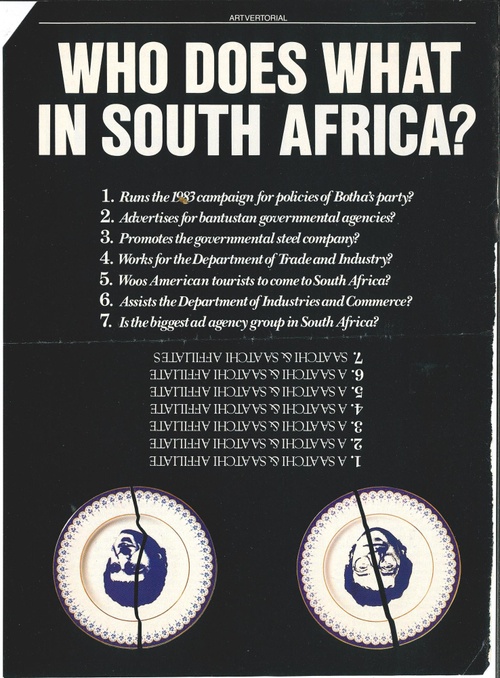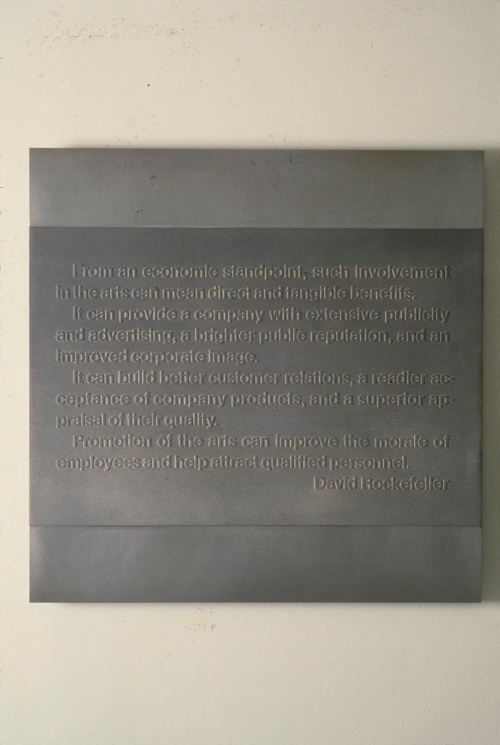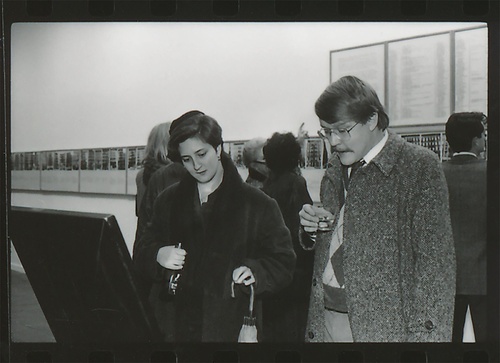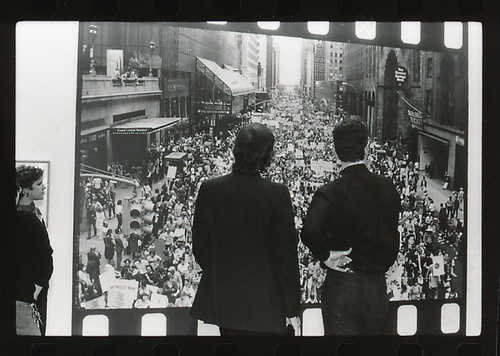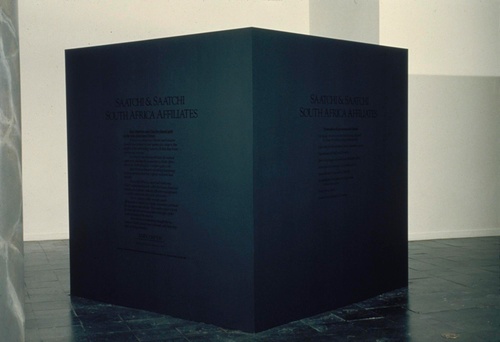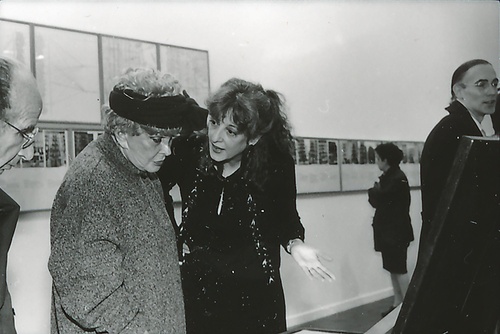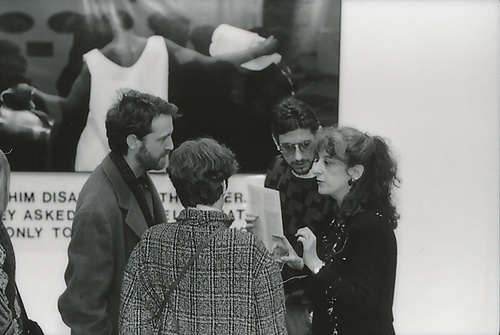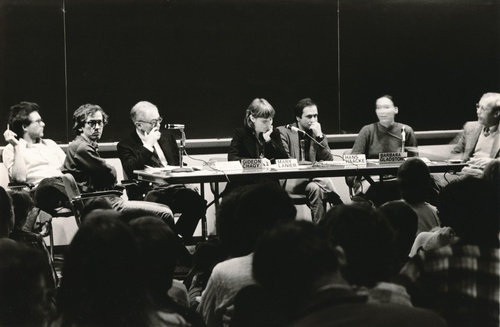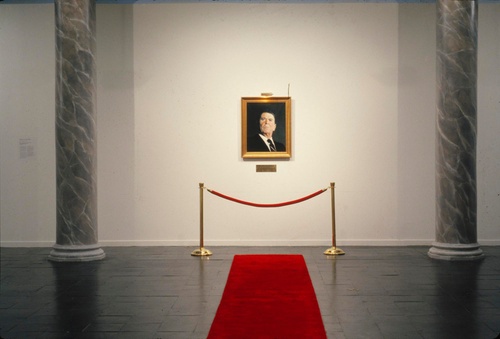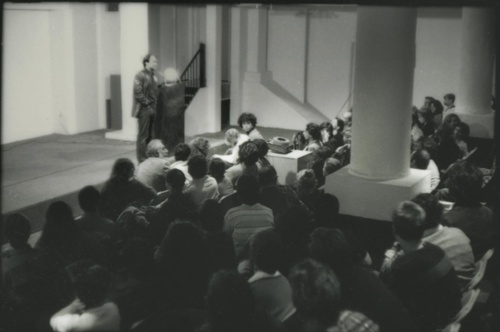Critical Object Study: Hans Haacke, Who Does What in South Africa?, 1987
ATLAS: Summer/Fall 2019
This ATLAS Critical Object Study focuses on a single piece of archival ephemera related to the 1986 solo exhibition “Hans Haacke: Unfinished Business.” In conjunction with this exhibition, Haacke published an “artvertorial” piece in the page of the finance and lifestye magazine Manhattan, Inc. This object study dissects the complex iconography at play in both the visual language and context of the piece to demonstrate how Haacke connects the nodes of advertising, international geopolitics, business, and arts institutions of the 1980s.
The 1986 New Museum retrospective of Hans Haacke marked the artist’s first major solo museum exhibition since the cancellation of his planned Guggenheim show in 1971. The Guggenheim’s director, Thomas Messer, had pulled the show and fired its curator Edward Fry, on the grounds that Haacke’s work on social systems—in particular, his 1971 project Shapolsky et al. Manhattan Real Estate Holdings, a Real-Time Social System, as of May 1, 1971, which documented the holdings of a New York slumlord—boldly allowed for an “alien substance to enter the art museum organism.” 1 Further communication from Messer in letters to Haacke, Fry, and various art news publications made it clear that the “alien substance” of which he was so afraid was in fact art that seemed to pursue “active engagement toward social and political ends.” 2
Following the Guggenheim controversy, Haacke’s work did not become less political or less “parasitic” in the ways Messer implied. Throughout the 1970s and 1980s, he continued to focus his particular brand of institutional critique on arts institutions and the rise in corporate funding of major blockbuster exhibitions, like the Metropolitan Museum of Art’s shows of ancient Nigerian art (1980) and Māori art (1984), both largely underwritten by Mobil. From this, Haacke expanded his study of economic systems and the arts to include targets that were seemingly further afield, including the advertising and image-relations giants Saatchi & Saatchi and its affiliates. He also began to consider the roles of placement and context in the way his art framed systemic relationships of power and interest. If Shapolsky et al. could be considered a parasite within the walls of the museum, how might an artist similarly intervene in those cross-sections of the economy where advertising, art, geopolitics, and branding meet?
Uncovered during research for the New Museum’s 2019 Hans Haacke retrospective, this torn-out magazine page exemplifies exactly the kind of parasitic framing that Haacke continued to engage with throughout the late 1970s and 1980s. This piece ran as an advertisement in the now-defunct finance and lifestyle magazine Manhattan Inc. in the winter of 1986-87, timed to coincide with Haacke’s first New Museum exhibition. By mimicking the visual qualities and forms of engagement typical of advertising at the time, Haacke leans into the charges of alien invasion once leveled against him by Messer, letting his art slip comfortably into the skin of advertising. With the glossy paper, large font, and use of questions that engage the reader/consumer directly yet informally, Haacke’s “artvertorial,” as he termed it, clearly draws from what was at the time extremely familiar visual language for luxury goods and buzzy technology brands like Rolex, BMW, Apple, and IBM.
Unlike the Pop art of Andy Warhol, James Rosenquist, and Roy Lichtenstein, which borrowed the languages of advertising and mass media only to resituate them back in oil paint on the gallery wall, a crucial component of Haacke’s work here is the maintenance of context for this particular encounter between reader and advertisement. As art historian John A. Tyson argues, “Almost any reproduction of Haacke’s information-laden artwork can function ‘parasitically’ when situated inside other texts.” 3 Just as the presentation of poll results or other demographic information about exhibition visitors functions in the most impactful way when shown inside the institution, the significance of Haacke’s text-based artvertorial works hinges on their context. The work’s appearance in the pages of Manhattan Inc., a publication that came to typify the particular culture of wealth and social ambition in 1980s New York City, is just as critical as the information it conveys.
The piece itself poses eight questions, beginning with “Who Does What in South Africa?” and continuing on to ask:
- [Who] Runs the 1983 campaign for policies of Botha’s party?
- [Who] Advertises for bantustan governmental agencies?
- [Who] Promotes the governmental steel company?
- [Who] Works for the Department of Trade and Industry?
- [Who] Woos American tourists to come to South Africa?
- [Who] Assists the Department of Industries and Commerce?
- [Who] Is the biggest ad agency group in South Africa?
The answers to each are presented beneath the questions, flipped upside-down like the kind of multiple-choice legend one might find in Cosmopolitan or Seventeen, and they are all the same: “A Saatchi & Saatchi Affiliate.” Saatchi & Saatchi was a particular target of Haacke’s in the 1980s, even though the company—a conglomerate of ad agencies and public relations firms—might seem to have little to do with the art world. Yet by the 1980s, the two Saatchi brothers, Maurice and Charles, had quietly become leading collectors of contemporary art as well as “advisers” to some of the world’s major art museums, most explicitly through the establishment of the Patrons of New Art Committee at the Tate museum in London.
As art critic Arthur C. Danto lays out, the entanglement of the Saatchi brothers, the Patrons of New Art Committee, and the Tate typifies the kind of shrouded relationships that Haacke aimed to render more transparent—especially as they implicated artworks, artists, and arts institutions in a broader set of geopolitical systems that he found especially troubling. In the early 1980s, Charles Saatchi served as a guiding member of the Patrons of New Art Committee, which, despite being “a private association with the goal of acquiring and donating contemporary works to the Tate,” also clearly had “an influence on the museum’s exhibition policies.” 4 An exhibition of paintings by the artist Julian Schnabel was mounted at the Tate in 1982; nine of the eleven works on view were owned by Charles Saatchi and his wife Doris. 5 According to Danto, the blurry relationship between public and private interests in the art world allowed the Saatchis to include the Schnabel works they owned in the Tate exhibition and thus “conferred the needed spiritual authority on the artist, whose values (read: prices) were [then] secure and enhanced.” 6 In the 1986 artvertorial, Haacke references both the Saatchis and this particular instance of backdoor value exchange through the rendering of two upside-down broken ceramic plates at the bottom of the page. Each plate bears a portrait of one Saatchi brother, and the broken ceramics themselves are a direct reference to the Schnabel exhibition: in the 1980s, Schnabel was best known for his paintings featuring mosaics of shattered plates.
Haacke also signals to another concerning aspect of corporate interests manifesting in public institutions. As a global public relations and advertising firm, Saatchi & Saatchi and its affiliates had dealings with governments, companies, and individuals across the planet—including the election campaign of former British Prime Minister Margaret Thatcher. None of these business relationships outwardly had anything to do with art or art museums, but through initiatives like the Patrons of New Art Committee, they ended up positioning the art world as a crucial node within a much larger system of power, politics, and monetary exchange.
Who Does What in South Africa? hones in on a Saatchi & Saatchi affiliate enterprise that was of major concern for Haacke in the 1980s: the business of propping up racist policies in apartheid South Africa. As Haacke commented in 1984, following his own Tate exhibition, “The Saatchi’s South African subsidiary took it upon itself to run the promotion of the constitutional change that was presented in a referendum to the white voters by the South African government’s National Party. Foes of apartheid think that this change, in effect, cemented the system which reserves political power in South African exclusively for the white minority, which constitutes sixteen percent of the population.” 7 Haacke’s 1986 artvertorial makes explicit reference to the Saatchi & Saatchi affiliate’s public relations and advertising work for both the Bantustan party and the policies of the Botha government—two names that signaled pro-apartheid policy in the 1980s. Further references in the list of questions to Saatchi & Saatchi’s public relations work for the government-owned steel industry, tourism efforts, and commerce departments point directly at how global conglomerates worked on local levels to prop up the racist politics of South Africa’s white minority government by countering sanctions and attempting to boost the economy through tourism and other soft-power methods.
Most of these complex, multilayered relationships would be completely opaque to the general gallery visitor or museumgoer. Haacke aims to frame these relationships out in the open—either very simply, as with the seemingly objective demographic information of his polls or gallerygoer surveys, or with slightly more wryness, as is the case with the iconographic puzzle of the artvertorial or Taking Stock (Unfinished) (1983–84), a gilt-framed portrait of Margaret Thatcher that premiered at Haacke’s own Tate exhibition in 1984. Taking Stock (Unfinished) sets Thatcher’s likeness in a library setting that overflows with allegorical references to Saatchi & Saatchi, who were infamously involved in the branding and messaging of her election campaign in 1979. With the form and context of Who Does What in South Africa?, however, Haacke goes one step further, self-reflexively referencing the messaging and modes of advertising—Saatchi & Saatchi’s bread-and-butter industry)—and taking his most “parasitic” form of engagement off of the walls of the museum and into the wider world.
Maggie Mustard, Ph.D.
Marcia Tucker Senior Research Fellow, New Museum
Published November 13, 2019
-
Benjamin H.D. Buchloh, “Hans Haacke: Memory and Instrumental Reason,” in Neo-Avantgarde and Culture Industry (Cambridge, MA: MIT Press, 2000), 208.
-
Jack Burnham, “Hans Haacke’s Cancelled Show at the Guggenheim,” Artforum, Summer 1971, https://www.artforum.com/print/197106/hans-haacke-s-cancelled-show-at-the-guggenheim-37767
-
John A. Tyson, “The context as host: Hans Haacke’s art of textual exhibition,” Word & Image 31, 3 (September 2015): 213.
-
Yve-Alain Bois, Douglas Crimp, Rosalind Krauss, and Hans Haacke, “A Conversation with Hans Haacke,” October 30 (Autumn 1984): 27.
-
In 1984, Haacke was invited to show work at the Tate in the exact gallery where the Schnabel exhibition had been located. In this exhibition, he premiered the work Taking Stock (Unfinished) (1983–84), an oil painting by Haacke that incorporated much of the same iconography as the artvertorial, referencing Saatchi & Saatchi’s public relations work for the election campaign of Margaret Thatcher. See https://archive.newmuseum.org/images/3081.
-
Arthur C. Danto, “Hans Haacke and the Industry of Art,” in The Wake of Art: Criticism, Philosophy, and the Ends of Taste (New York: Routledge, 1988), 135.
-
Bois et al., “A Conversation with Hans Haacke,” 25.
